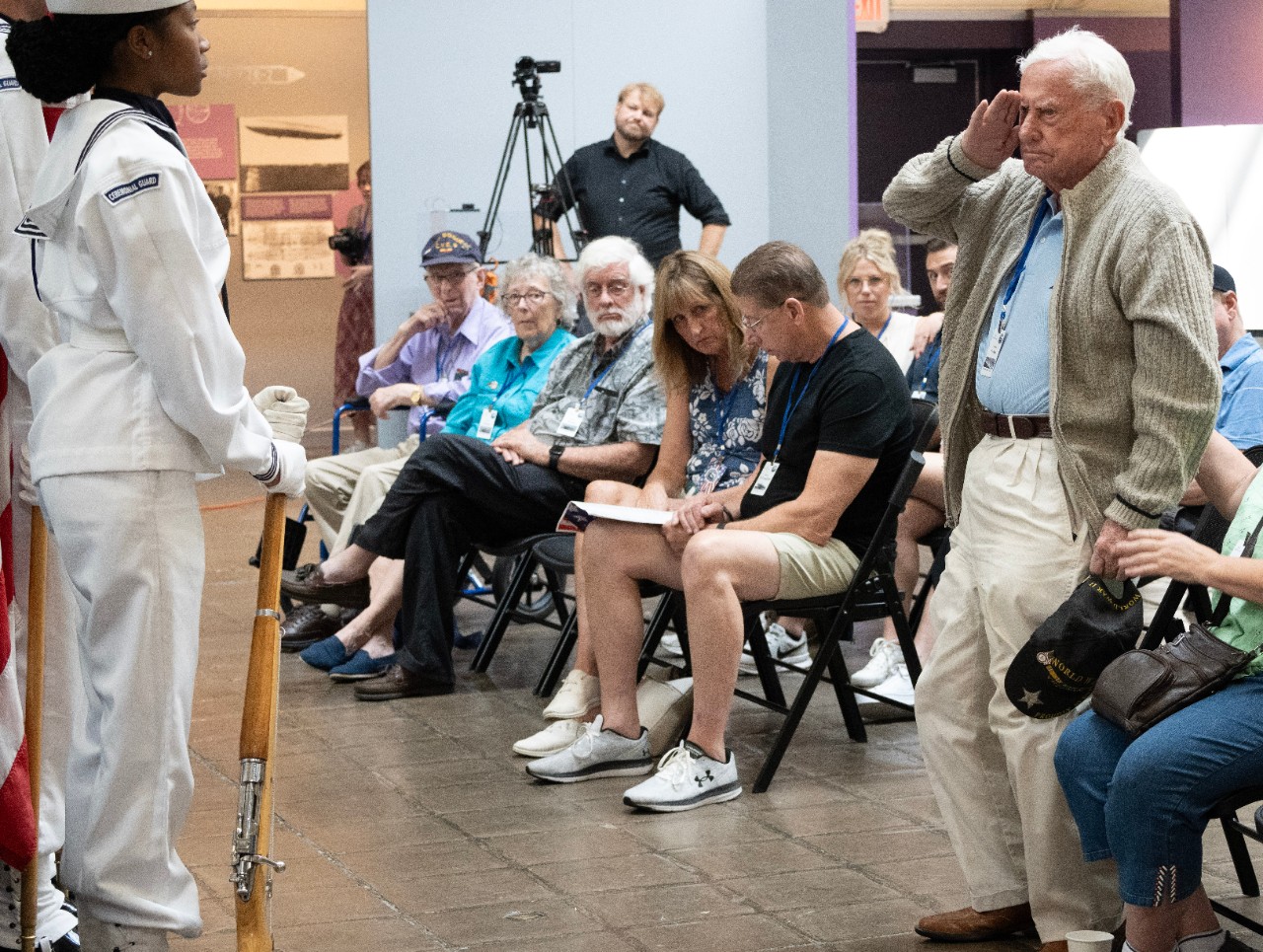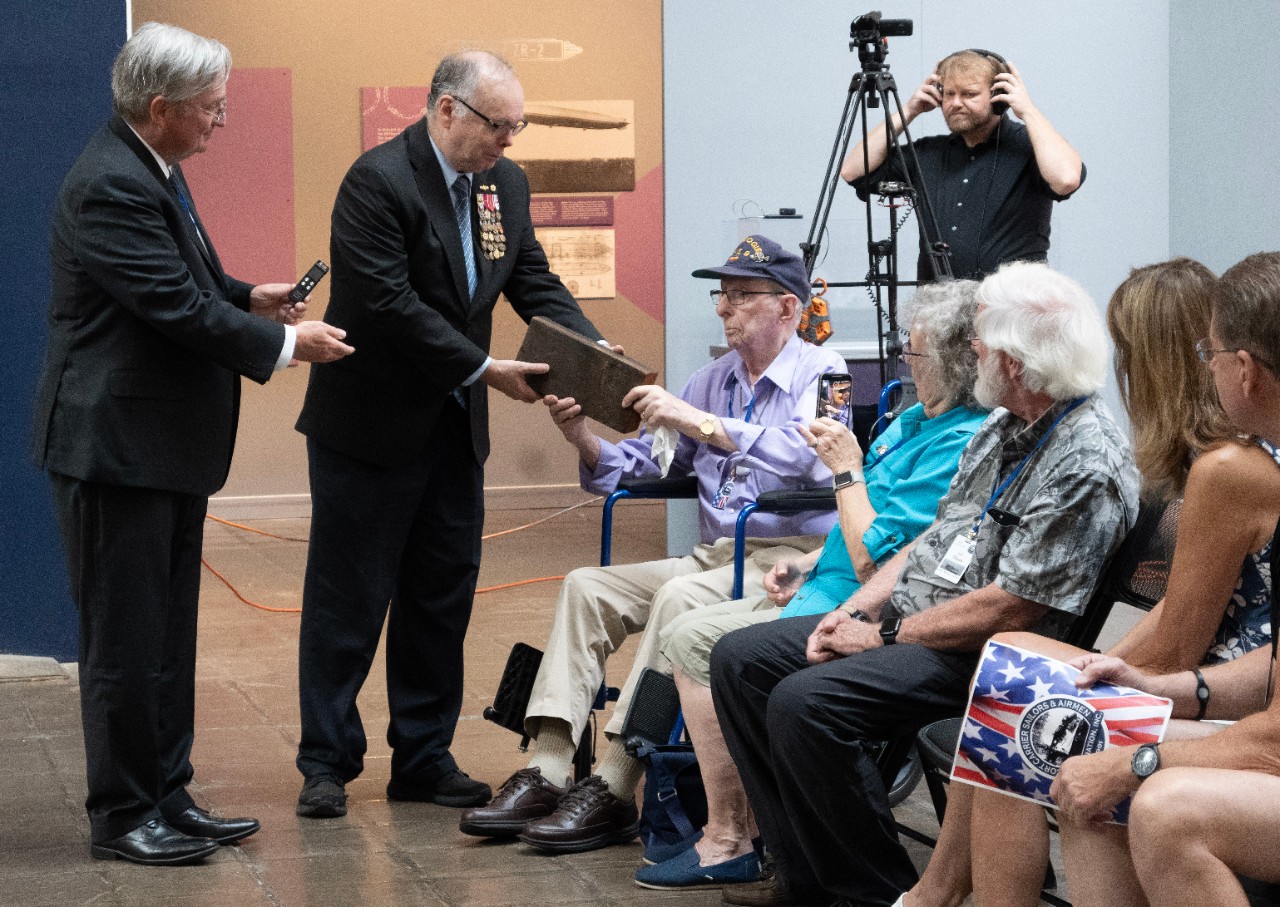
Photos and story by Monica McCoy
As the call, “Parade the Colors,” was solemnly sounded out in the gallery hall of the National Museum of the United States Navy, World War II veteran Robert Kruger struggled to rise from his wheelchair with the assistance of his daughter Vicki Wilson and others nearby. It was the last time the 100-year-old vet would attend an Escort Carriers Sailors and Airmen reunion, and he had donation to offer.
The Escort Carriers Sailors and Airmen Association (ECSAA) convened at the Washington Navy Yard Aug. 26, not just for their annual memorial service and membership meeting but to embark on a new mission. With the passing of so many WWII veterans and so few remaining on their ECSAA rolls, the group sought to honor their fallen comrades and redirect their efforts from a reunion mission to one of historical preservation.
National Museum of the U.S. Navy Director Charles Swift welcomed the visitors and their families to the museum, emphasizing the ongoing efforts for the new Navy museum. Swift said the planned museum, located outside of the gates of the Navy Yard, would grant the American public easier access to learn about naval history, including the crucial role of Escort Carriers.
"When we talk to active-duty Sailors about what they would like to see in a new Navy museum, they tell us they want to hear the stories of those who have served. Organizations such as yours preserve those stories, which are such an important part of the new museum project,” shared Swift.
NHHC Director Samuel Cox followed Swift, delving into the 30-year legacy of Escort Carriers in history.
"The story of the Escort Carriers and their service from WWII to Korea through Vietnam is one of valor and sacrifice in course of victory," said Cox. "These ships served many functions and were key in defeating the German U-boat threat. Several of these ships went up against Japanese battleships off Leyte Gulf in one of the heroic actions in U.S. naval history. Others survived hits by Japanese kamikaze suicide planes. Six U.S. Navy escort carriers were lost in WW2 with tragically heavy loss of life, whose sacrifice we commemorate today.”
An invocation by Arlington National Cemetery Staff Chaplain Lt. Regina Johnson followed Cox and the Call to Colors sounded, marking the memorial for all who had crossed the bar since the last reunion. A bell rang out for each name on a long list, and the veterans rose to salute their fallen Escort Carrier shipmates. Taps, played by U.S. Navy Band Bugler MU1 Jesse Saldana, echoed through the museum gallery surround by pieces of history from others who had paid the ultimate price in service to our nation.
With the memorial complete, ECSAA Board of Governors President David Ryan asked the attending members to vote to decommission the ECSAA's reunion mission and refocus the organization's efforts on historical preservation. Once the vote was confirmed, Ryan presented Director Cox with donated artifacts.
"On behalf of Nancy (Houlihan) Fitzgerald and the family of John William Houlihan, we would like to present Naval History and Heritage Command with some of his pieces," offered Ryan. "Houlihan was a radioman/gunner flying off the USS Gambier Bay (CVE 73). His family has donated his bomber jacket, two Navy uniform tops, and his 'Crossing the Equator' certificate, which he just happened to send home stateside before the Gambier Bay was sunk.
"We also have a donation from Bob Kruger, who is with us today. Bob is a WWII veteran and has a plank of wood from the flight deck of USS Bogue (CVE 9), where he served," said Ryan.

Kruger, once again seated in his wheelchair, offered the weathered plank with hands unsteady from age.
"Naval History and Heritage Command has more than 500,000 artifacts in its collection," said Cox. "And we hold on to these pieces and care for them because they are important pieces of our naval memory. We value the support of veteran organizations such as yours to ensure the sacrifices made by our Sailors will never be forgotten. The artifacts presented today will help us share the story of Escort Carriers, and as the Senior Curator for the Navy, I am honored to accept."
At the conclusion of the ceremony, Kruger, his fellow CVE veterans, families, and friends engaged with leadership, observed the received donations, and toured the artifacts and collections on display throughout the museum, including a collection of donated art documenting aspects of carrier service during WWII.
"It was so important for my dad to be here today," said Kruger's daughter, Vicki. "He didn't want to come in a wheelchair. He doesn't like using it, but we insisted because it's such a long trip for him."
The Naval History and Heritage Command, located at the Washington Navy Yard, is responsible for the preservation, analysis, and dissemination of U.S. naval history and heritage. It provides the knowledge foundation for the Navy by maintaining historically relevant resources and products that reflect the Navy's unique and enduring contributions through our nation's history, and supports the fleet by assisting with and delivering professional research, analysis, and interpretive services. NHHC is composed of many activities including the Navy Department Library, the Navy Operational Archives, the Navy art and artifact collections, underwater archeology, Navy histories, nine museums, USS Constitution repair facility and the historic ship Nautilus.
For more information on donating artifacts to Naval History and Heritage Command, visit https://www.history.navy.mil/get-involved/donate-materials.html.


